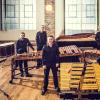
In the vast compendium of live performance, the compositions of Dan Tepfer — a classically trained pianist, adept jazz improvisor, highly skilled computer programmer, and digital graphic artist — hold a unique position. Back in the day, we would have described the experience as far-out and psychedelic. Tepfer describes his recorded music and live performances as explorations in “a digital playground” where “the algorithmic and the spiritual” intersect.
Born an American (in Paris) in 1982, Tepfer has recorded and performed around the world with notable jazz and classical artists, from Lee Konitz to Renée Fleming. He’s released a dozen recordings of his original compositions and gained acclaim for his 2011 album Goldberg Variations/Variations, in which he combines highly skilled literal renditions of Bach’s masterwork with free-spirited improvisations.
On Sunday at UCLA’s Nimoy Theater, Tepfer offered the Los Angeles premiere of his 2018 multimedia project Natural Machines — a compendium of computer-enhanced improvisations performed on a Yamaha Disklavier that responds to Tepfer’s playing in real time. Separately, a computer transforms the music into visual patterns.
Real-time signal processing has been around for a while, and Tepfer uses a platform called SuperCollider that was originally released in 1996. Using the program, Tepfer doesn’t so much compose as write algorithms, rules for the computer to follow. Playing the Disklavier, he improvises, the computer responds, and then Tepfer listens for those responses as he continues. That interaction between human and machine gives the project its title.
As a result, he can perform music far beyond the limits of human anatomy. Think of it as piano two-hands, four-hands, six-hands. And depending on the algorithmic rules, Tepfer’s playing might be mirrored in intervals, layered into multivoiced canons or triads, or replayed with the melodic themes inverted or backward — as Tepfer illustrated by performing one of Bach’s Goldberg Variations as composed and then “commanding” the computer to play the performance it had just recorded, but in reverse.
The effect of watching Tepfer perform is like a visual-auditory three-ring circus. As he plays, a camera positioned above projects the full keyboard at the far right of a large screen. As each composition evolves, the remainder of the screen fills with a succession of ever more complex, computer-generated animations based on the piece’s specific algorithm. At the same time, the view of the keyboard shows the invisible ghostly fingers of the Disklavier at work.

For years, musicians have enjoyed the ability to expand their musical vocabularies and physical limitations with the aid of technology, a notable example being Wendy Carlos’s 1968 electronic fusion (and runaway hit) Switched-On Bach, which in many ways serves as a link between the Baroque master and Tepfer.
But if the Disklavier represents a player piano for the digitized 21st century, then mention must be made of the greatest player-piano composer of all time, Conlon Nancarrow, who, alone in exile in Mexico City, punched out piano-roll compositions that not only went beyond the realm of human dexterity but produced music in a realm all its own— note patterns of immense complexity combined with passages played at the speed of light.
Unlike Nancarrow, however, Tepfer is not interested in musical revolutions (not even the Beatles’ “Revolution No. 9”). His music is not the radically new language thought up by Nancarrow, much less the colliding musical cosmologies created by Karlheinz Stockhausen and other electronic-music pioneers. Instead, Tepfer’s music is a mix of Bach and Bill Evans: familiar, pleasing, and extraordinarily well made. Tepfer’s skill set is remarkable, and his piano playing is dexterous and imaginative.
The skill of his playing combined with the exponential possibilities of the Disklavier and the stunning beauty of his diagrammatic animations makes Natural Machines a delight to hear and behold.



